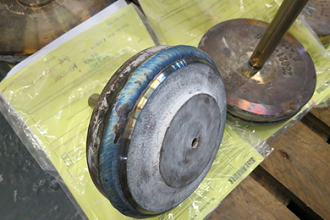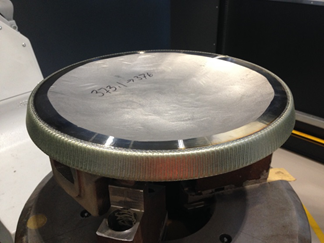Hardfacing for Valves: Materials and Processes
Valve internals, such as seats and closures, are often at risk of erosion, abrasion, corrosion, galling and damage from cavitation.
#materials
Erosion is material weight loss caused by the process flow, especially if the fluid contains particles. Corrosion can accelerate the erosion, and even a material that is completely resistant to erosion and corrosion may fail due to galling. Galling is a form of wear caused by adhesion between two sliding surfaces and usually occurs when components that have similar hardness slide over one another in a dry or non-lubricating fluid condition. Cavitation happens when the pressure in a liquid suddenly drops and bubbles of vapor form in the liquid. When the bubbles collapse, this creates pressure waves that can damage the valve internals. Cavitation can produce irregular pits and erosion inside the valve, as well as noise and vibration.
Hardfacing is a metalworking process where harder material is applied to vulnerable surfaces to mitigate such damage. Whole components could be made from the hard materials, but that generally is a much more expensive solution. Internal parts of many different types of valves may benefit from hardfacing, such as gate, globe, check and butterfly valves.
Metallic alloys for hardfacing can be deposited by different processes, including:
- Welding
- Flame Spraying
- Plasma Spraying
- High Velocity Oxygen Spraying
- Laser
To ensure the quality of a hardfacing application, test for hardness, corrosion, thickness, adhesion, and other characteristics of the overlay, and perform a metallographic examination of the base material, as well.
HARDFACING MATERIALS
The material most often used for hardfacing valve internals is Stellite 6, a cobalt alloy that contains chromium, tungsten, carbon and other elements (Figure 1). Table 1 gives the chemical composition and some physical properties of Stellite 6 alloy. A hard carbide phase in the CoCr alloy matrix makes this material highly resistant to corrosion and galling.
22Cr duplex stainless steel is widely used for piping systems, including valves, in the offshore industry. However, applying Stellite 6 on 22Cr duplex is challenging due to formation of a sigma phase in 22Cr duplex during welding, which can result in embrittlement. Chromium and molybdenum generally increase the rate of sigma phase precipitation. The risk of sigma phase formation is higher in smaller and thinner duplex components with Stellite 6 overlay due to higher heat concentration during weld overlay. Instead of using Stellite 6 overlay on smaller sizes 22Cr duplex components (e.g., 4 in. and less), an alternative is to make the components from solid Stellite 6 to avoid the problems associated with weld overlay.
Seawater applications are not suitable for Stellite 6, as it is at high risk of cracking in that environment. Ultimet or Triballoy are hardfacing materials more suited to valves used in seawater service.
Another cobalt alloy, Ultimet (UNS R31233), also offers excellent wear resistance properties. Ultimet contains chromium, nickel, molybdenum, iron and tungsten. Valve manufacturers have found Ultimet somewhat more difficult to overlay than Stellite 6. Achieving sufficient adhesion of Ultimet with the base material can be a challenge in some cases, which leads to loss of the weld overlay after some years of operation. The offshore industry commonly uses Ultimet overlay on components of 25Cr duplex valves used in sea water.
Hardfacing with nickel- or cobalt-based Tribaloy alloys can protect components subject to extreme wear, high temperature or corrosive materials. The Tribaloy 800 alloy contains a high amount of molybdenum, which increases resistance to pitting corrosion in seawater service. This cobalt-chromium-molybdenum alloy also features high resistance to erosion, corrosion and galling.
A combination of tungsten and carbon, tungsten carbide tolerates high temperature and provides extreme abrasion resistance. Figure 2 shows a ball for a ball valve after application of a tungsten carbide coating and lapping.
Tungsten carbide coatings are often applied by a high velocity oxygen fuel (HVOF) thermal spray process. This process propels coating particles toward the substrate surface at extremely high velocity and they fuse to the surface due to their kinetic energy, rather than an elevated temperature. The thickness of a tungsten carbide coating is typically held to 150 microns or less, due to porosity issues with thicker coatings.
CASE STUDY OF STELLITE 6 HARDFACING THROUGH LASER OVERLAY
Laser cladding offers many advantages compared to traditional welded overlay, including less overall heat input, a smaller heat-affected zone, reduced thermal distortion, better bonding, more uniform layers of overlay and a lower rate of iron from the substrate diluting the Stellite. Figure 3 shows the laser tool used for applying Stellite 6 or other material on the disk and seat of metal-seat butterfly valves. Figure 4 shows the result: a high-quality Stellite 6 overlay on the contact surface of the disk.
CONCLUSION
Valve internals such as seats and closure members can be at high risk of erosion, abrasion, corrosion, galling and damage from cavitation. Hardfacing—applying harder material to vulnerable parts—can mitigate such damage. A hardfacing material, such as Stellite, Ultimet, Tribaloy or tungsten carbide, can be applied by welding, spraying, HVOF or laser. Different hardfacing materials are suited to different operating conditions, and the process used for overlaying hard materials must be compatible with both the overlay material and the substrate. Care must be exercised in selecting both the hardfacing material and the application method.
Reza Karimzadeh is senior HVAC and mechanical engineer at Aker Solutions.
Karan Sotoodeh is senior/lead valve engineer at Baker Hughes, a GE company.
RELATED CONTENT
-
New Technologies Solve Severe Cavitation Problems
An advanced anti-cavitation control valve design enabled by 3D metal printing solved a power plant’s severe cavitation problem and dramatically improved its bottom line.
-
Dealing with Sand Erosion in Control and Choke Valves
Sand erosion in control and choke valves is a significant consideration offshore.
-
Control Valves for Hydrogen Applications
Proper sizing, material selection and monitoring are as important as ever.















 Unloading large gate valve.jpg;maxWidth=214)